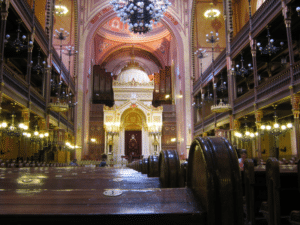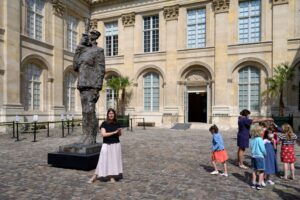The Great Synagogue is located in the 9th district, in the quiet street “Rue de la Victoire”.
With the Great Synagogue in Budapest, it is the largest synagogue in Europe and definitely one of the most beautiful synagogues in the world.
The Great Synagogue of Paris La Victoire was built a little less than 100 years after the French Revolution and it will celebrate its 150th anniversary in 2024.
The French Revolution has also been the Jewish Revolution.
Because suddenly discrimination stopped and Jews were allowed to go where the wanted to, were free to practice their Judaism, and finally were allowed to apply for any job they wanted, both in the private and public sector.
A few years later Napoleon Bonaparte ruled, and he decided that each province in France should have at least one synagogue for every 2000 Jews.
As there were a lot of Jews in Paris, two synagogues were built, one Sephardic, the other Ashkenazy.
They were built in the Marais, now a hip and trendy neighborhood, but then mostly a Jewish and working-class area.
But these synagogues were small and insignificant, so in the first half of the 1800-s, James de Rothschild, the very first founder of the Parisian Rothschild dynasty, decided to fund the construction of a larger synagogue.
This synagogue was built close to the Marais, in a narrow street.
Soon this synagogue became too small as the Jewish population continued to grow.
In the meantime, Napoleon Bonaparte was gone, France went back to becoming a Kingdom and then again was ruled by an emperor, Napoleon the 3rd.
During this time the number of Jews that moved to Paris had doubled, in 1861 they were 30.000.
In the same time the country went through the exiting period of the industrial and cultural revolution, with the opening of new banks, insurance companies, department stores, theatres and railroads.
The Jews participated actively in this industrial and cultural revolution and Napoleon the 3rd was very grateful to them.
So, when the son of James the Rothschild, Gustave, asked Napoleon the 3rd if he agreed to the construction of a new Great Synagogue, he could only agree.
Business was concluded quickly.
Gustave de Rothschild insisted that the Great Synagogue was built in the business district, close to where the banks, the Opera House, several leading theatres and the department stores were.
The city of Paris offered a plot of land and Gustave the Rothschild financed the construction of the synagogue.
The architect, Alfred Aldrophe, designed the huge synagogue.
The style was a mix of Romanesque and Neo-Byzantine.
Inside it had a central nave with a very high ceiling, flanked by two side aisles, an apse with the Holy Arc and a grand staircase.
Outside, the impressive and wide façade received 3 arched entrances.
The visitors were welcomed by a phrase from the Book of Isaiah, engraved in the facade.
The phrase relates to the Prophet Isaiah promising” a house of prayer for all people”.
Isaiah promised a few lines further to build a “ Yad Vashem”, meaning a Memorial for the Name.
Yes, the origin of the name of the Holocaust memorial in Jerusalem, Yad Vashem, comes from the same chapter.
Inside the Synagogue, the architect built a monumental staircase that until today leads to the women’s section.
The 12 stained glass windows represent the 12 tribes and the names of the prophets were written in the ceiling, as well as the 10 commandments along the gallery.
The Holy Arc is monumental and magnificent.
In front of it stands an impressive solid silver candle holder offered by Gustave Rothschild.
The Ner Tamid was also offered to the synagogue by Gustave.
Like all the synagogues that were built in those days, an organ was installed to accompany the services.
There was one little problem : Napoleon the 3rd was very fond of the Jews, but his Spanish, Catholic wife, Eugenie, was not.
When she discovered that the majestic entrance of the synagogue was opposite two Catholic churches, she contacted the architect.
She insisted the building was turned to make sure the Catholics would never bump into Jews, when going to their churches.
Because of Eugenie, the Great Synagogue is turning its back to a large, busy street and is not turned towards Jerusalem.
But that didn’t prevent the Great Synagogue to be majestic, magnificent and impressive.
In 1874 the first service was celebrated.
And a few years later Gustave Rothschild’s daughter celebrated her wedding in what was to be remembered as one of the most glamourous and beautiful weddings ever celebrated in the Great synagogue.
Unfortunately, the marriage was not a happy one, and I will tell you all about it when we visit the Great Synagogue together.
Alfred Dreyfus, sadly famous for the Dreyfus affair, married here as well.
So did Leon Blum, before becoming the President of France.
I also have lots to tell you about the tumultuous life of these two gentlemen.
When Theodor Herzl resided in Paris in the 1890-s, he came several times to the Great Synagogue.
In his diary he wrote it reminded him of his hometown, Budapest.
When WW II started, the Chief Rabbi, Julien Weill, was evacuated to the South of France where he was safe.
But shortly after a bomb exploded in front of the synagogue, he decided to come back.
He wanted to be with his community during these difficult times and remained in Paris until the end of the war.
Thanks to him, services were daily during the remaining years of the war and every Shabbat and every High Holiday, services continued as well.
He even continued to celebrate weddings and bar-mitzvahs during the whole period of the war.
Nazis and French collaborators threatened him, molested him, sacked his apartment several times, profaned the Holy Arc, but he never gave up.
In 1943, after the Rosh Hashana service, the Gestapo held an identity check as the Jews were leaving the building.
But somebody had warned the Rabbi so those who had no valid papers managed to hide inside the building and nobody was arrested.
After the war, some Jewish worshippers who were lucky to return alive to Paris, were amazed to find their prayerbooks and shawls back were they left them, in the case under their chair.
The Great Synagogue went back to functioning normally.
The Ashkenazy ritual from Frankfort was continued but this was challenged when many Jews from North Africa arrived in the 1950-s.
They were religious and did not feel at ease hearing the Ashkenazy melodies.
So, two small synagogues were opened for them within the building of the Great Synagogue.
In 1967 the Great Synagogue went through a large renovation.
A year later, during the student revolution, Jewish students occupied the Great Synagogue.
They protested against the use of the organ on Shabbat.
And they demanded that the choir no longer be mixed but only for men.
This was a sort of reversed revolution. The students did not ask for progressive reforms but for stronger orthodoxy.
Their demands were granted.
Ever since, the organ has not been played on Shabbat anymore and the choir is 100% male.
Today the Great Synagogue has about 2000 members. Some of the members’ great, great grandparents were members already, and their family names are still engraved in the chairs.
The Chief Rabbi of France is the leader of all the French Jewish communities and sits in this synagogue.
The Chief Rabbi is elected every 7 years among the members of the French Jewish community.
On my visit I will tell you so much more about the history, the architecture, the happy events, the glamour and gossip as well as the darker times, like WW II.
Visiting the Grand Synagogue of Paris with a Guide:
Grab this opportunity to visit the most magnificent synagogue in Paris, that will only open for our group.
My next visit is planned :
22nd April 2024 – With Flora Goldenberg
Contact to join : flora.goldenberg@gmail.com









